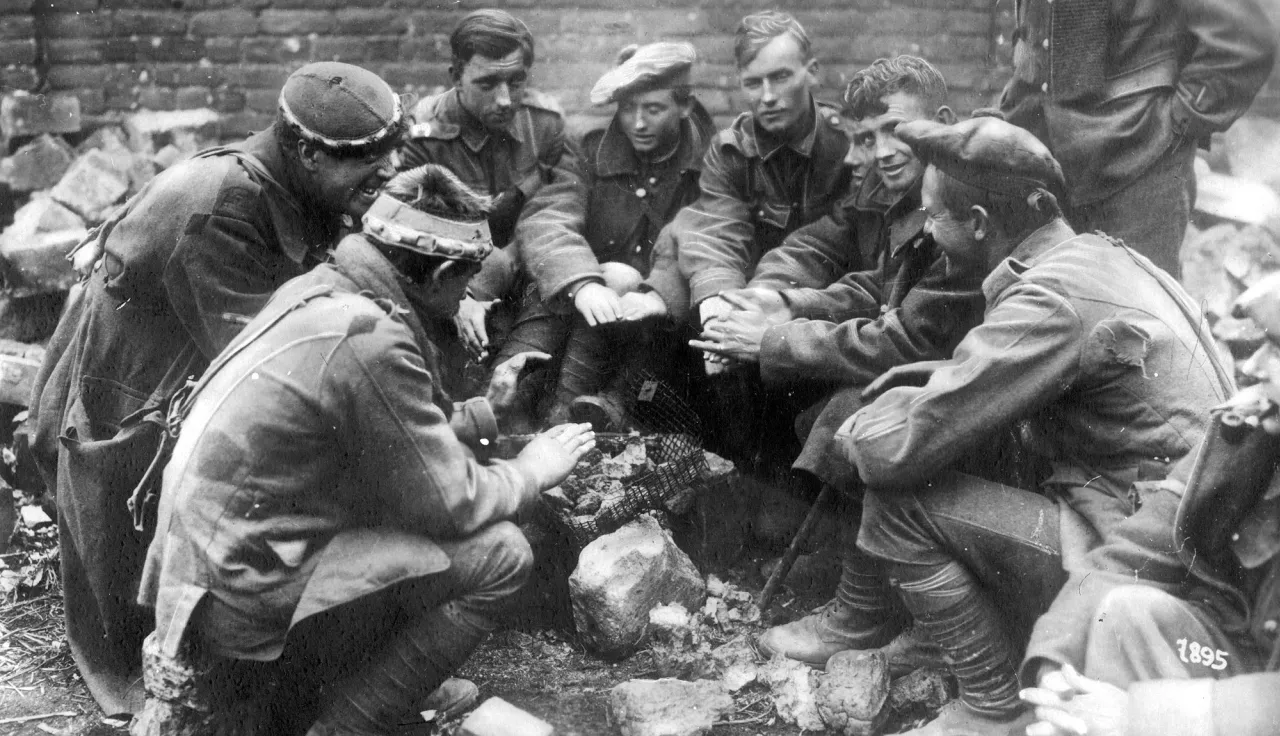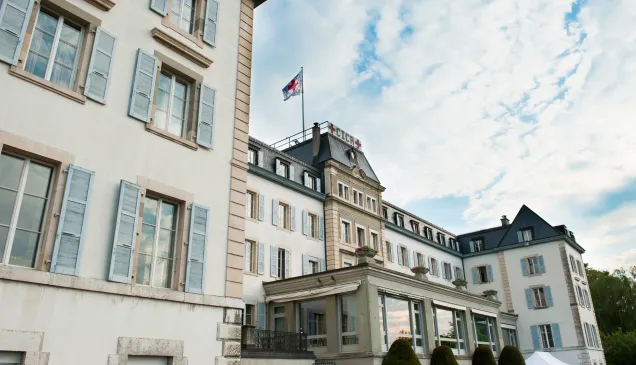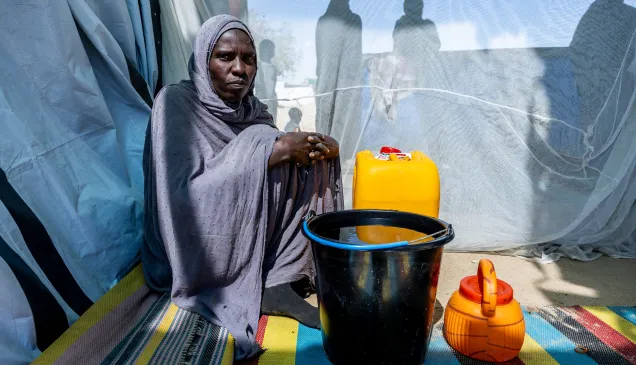The International Committee of the Red Cross in the First World War

At the outbreak of the Great War, the ICRC had already been operating for over 50 years. Although international in name, the ICRC was actually a local philanthropic association, inexperienced and, above all, small in size (only 10 members in August 1914). The First World War and its aftermath were to cause lasting change at the ICRC and begin developing it into what it is today.
At the outbreak of the Great War, the ICRC had already been operating for over 50 years. The organization had been founded in 1863 at the instigation of two Geneva citizens, Henry Dunant and Gustave Moynier. As Dunant had recommended in his famous work, A Memory of Solferino (published in French in 1862), the organization’s purpose at the time was to promote the creation of a National Society in each country (the future Red Cross Societies). In the event of war, these would come to the aid of wounded military personnel and would stand by to back up the medical services of the armed forces. Once those Societies had been set up, the ICRC acted as intermediary and kept them informed as to how the work of the Red Cross was progressing. At the same time, the organization approached governments to promote the 1864 Geneva Convention, which accorded wounded and sick soldiers neutral status, as it did hospitals and ambulances, thus protecting both sick and wounded soldiers and those assisting them. The ICRC also continued to promote laws and regulations with a view to constantly adapting humanitarian law to the changing realities of war such as technological innovations. Lastly, since the Franco-Prussian War of 1870-71, the ICRC had been helping wounded soldiers and prisoners by gathering information on their circumstances to pass on to their families. Although international in name, the ICRC was actually a local philanthropic association, inexperienced and, above all, small in size (only 10 members in August 1914). The First World War and its aftermath were to cause lasting change at the ICRC and begin developing it into what it is today.
The International Prisoners-of-War Agency
The organization’s transformation was indeed unparalleled, especially in terms of staff. Less than two months after the outbreak of hostilities, ICRC staff increased twelvefold. By the end of 1914, some 1,200 people were working for the organization, essentially in the International Prisoners-of-War Agency, which it set up on 21 August 1914. In the course of the war, some 3,000 people came to work for that Agency, whose role was to restore links between members of families separated by war. It was organized into 14 national sections (Franco-Belgian, British, Italian, Greek, American, Brazilian, Portuguese, Serbian, Romanian, Russian, German, Bulgarian, Turkish and Austro-Hungarian) as the various countries entered the war. There were also two specialized sections: for civilians and for health care. The Agency approached the warring parties and National Red Cross Societies to obtain information on the individual prisoners or other victims covered by its remit. This information was combined with the thousands of enquiries the ICRC received daily from families and was incorporated into a complex card-index system. Constantly updated, the cards served to keep track of the individual’s concerned and to provide enquiring families with information.
By the end of the war, the Agency in Geneva had over six million index cards (concerning some two and a half million people), a database of considerable size for the period, despite the fact that some of the national indexes were incomplete. The ICRC had in fact delegated the tracing work for the German-Austrian-Russian front to the Danish Red Cross, which had set up its own information agency. The data about prisoners on the Austro-Italian front did not go through the International Agency either, being exchanged directly between Rome and Vienna. In addition to prisoners of war, the Agency also concerned itself with civilian internees and civilians living in occupied areas. This was an innovation, since the scope of the ICRC's activities had not previously included civilians. Yet in 1914 civilians – who were protected by the Regulations respecting the laws and customs of war supplementary to the Hague Convention of 1907 – bore the brunt of the first months of the war and of the various subsequent military occupations on both the Western and the Eastern, and Balkan, Fronts. From the Agency’s inception , one of the ICRC’s members, Dr Frédéric Ferrière, ran a special section in the organization whose work was to respond to enquiries specifically concerning civilians (deportees, hostages, and people living in occupied territories).
The Agency was operated by volunteers to begin with. The members of the ICRC – who were also members of Geneva’s upper class – mobilized their relatives and friends to go through the growing piles of mail and both reply and enter the data on index cards. But it did not take long for paid employees to be recruited to keep up with this enormous task.
The Agency was not the only organization active in Switzerland during the First World War. In 1916, in Geneva alone there were some 50 groupings (almost 170 in Switzerland as a whole) working for the civilian or military victims of the conflict.
Humanitarian diplomacy
In addition to this information-collecting, the ICRC intensively lobbied the warring States. The aim was first and foremost to obtain authorization for ICRC representatives (which it called “delegates”) to visit prisoner-of-war camps. The organization began inspecting internment camps in Germany, the United Kingdom and France in January 1915. All main belligerents eventually granted permission for this. The ICRC dispatched a total of 54 missions to visit 524 prisoner-of-war camps in Europe, but also in Turkey, North Africa (Morocco, Tunisia, Algeria and Egypt) and Asia (Siberia, Burma, Japan and British India). The reports on these visits – which were also written by neutral protecting powers (Spain, the Netherlands, Switzerland, the Holy See and the United States until 1917) or by the Young Men's Christian Associations – were submitted to the governments concerned, but were also published … and sold.
The ICRC also discussed with the detaining powers the treatment received by prisoners of war and tried, for example, to oppose reprisals inflicted on them – a problem which, together with the notion that reciprocity should guide the detention of enemy captives, was ever-present throughout the war and a cause of constant concern to the ICRC. From October 1914 onwards, the organization also sought the exchange of seriously wounded and sick prisoners, i.e. their repatriation or at least their hospitalization in a neutral country. With the blessing of the Swiss government and after receiving permission from Germany and France, convoys of wounded prisoners began crossing Swiss territory from Konstanz to Lyon and from Lyon to Konstanz.
Throughout the war, the organization reminded the belligerent States of their obligation to abide by the treaties of international humanitarian law, in particular the Geneva Convention, which had just been revised in 1906. For example, it strove to have detained medical staff repatriated between France and Germany, as provided for by the Convention. In its practical implementation, this process met with numerous obstacles and interruptions. Similar difficulties arose regarding the repatriation of Belgian medical personnel.
As a neutral organization – and one which therefore would not be suspected of engaging in war propaganda for any party to the conflict – the ICRC forwarded numerous protests and allegations that had been addressed to it concerning violations of the Geneva Conventions or of the 1907 Hague Conventions governing naval warfare. The belligerents accused one another of shelling medical facilities and ambulances, seizing, attacking and torpedoing hospital ships, misusing the protective red cross and red crescent emblems for military purposes, etc. Given the number of violations of the Geneva Convention still pending, the 10th International Conference of the Red Cross proposed in 1921 that a special commission be set up and composed of representatives of six nations that had remained neutral during the war (Switzerland, the Netherlands, Spain, Norway, Sweden and Denmark) plus an ICRC representative. This commission, which was to examine these complaints, never actually materialized, however.
Given the threat of widespread use of poison gases not only at the front but also -- indeed primarily -- behind the frontlines, the ICRC went beyond its traditional remit, launching a solemn appeal to the belligerents on 8 February 1918 urging them to refrain from using "asphyxiant and poisonous gases". While officially welcoming this initiative, the States concerned did not really respond to the ICRC's exhortation, instead blaming their opponents for engaging in chemical warfare. It was not until the conflict had ended that the massive use of such weapons was finally outlawed. After the war, the ICRC continued its efforts, mainly through representations to the League of Nations, to bring about an outright ban on gas warfare. It contributed directly to the drafting of the Protocol for the prohibition of the use of asphyxiating, poisonous or other gases, and of bacteriological methods of warfare (also known as the Geneva Protocol) of 17 June 1925.
The war also made evident the limits of humanitarian law regarding various aspects of captivity for prisoners of war. Throughout the conflict, the warring parties had to negotiate ad hoc agreements amongst themselves to bridge this gap in the law of war. The ICRC drew lessons from this gap and, even before the hostilities had ceased, started thinking about drafting of a new code to protect captured servicemen. These efforts resulted in 1929 in the adoption of the Geneva Convention relative to the treatment of prisoners of war.
Relations with the National Red Cross Societies
The war did not affect relations between the ICRC and the various National Red Cross Societies (or Red Crescent Society, in the case of the Ottoman Empire), which assisted the medical services of the various armies and ran the relief operations for prisoners of war. The ICRC continued to keep the Societies regularly informed about its own activities and those of their counterparts through its Bulletin international de la Croix-rouge, which it had been publishing since 1869. It had abundant correspondence with the Societies that acted as intermediaries between the ICRC and their respective governments. Complaints of violations of the Convention were communicated to the ICRC through the National Societies and were forwarded through their counterparts to the political and military authorities. Though these Societies acted with complete independence from the ICRC, it was nevertheless the ICRC that was in charge of officially recognizing any newly created or reconstituted National Society. Thus, at the beginning of the war, the ICRC announced that a Red Cross Society had been set up in Luxembourg as soon as Germany attacked Belgium and had immediately begun working to deal with the emergency. The ICRC also protested vehemently – but in vain – against the dissolution of the Central Committee of the Belgian Red Cross by the occupying Germans in April 1915.
Women involved in humanitarian endeavour
The First World War caused significant social upheaval, including women moving into wholly unaccustomed activities to replace the men who had left for the war. This same thing also occurred at the ICRC itself since, of the 3,000 people employed by the International Agency, two-thirds were now women. These female staff members were mainly recruited as typists, one of the new professions open to women. But women also moved into the organization’s highest levels. In November 1918 the first woman ever was elected to the ICRC’s governing body, the Committee itself. Renée-Marguerite Cramer was already in charge of the Entente Department at the Prisoners-of-War Agency before she took her place on the Committee. It was a first for any international organization. Despite the reluctance of some of its members, the ICRC considered such changes inevitable, given the change in mentalities that had resulted from the war. There were also several women in charge of Agency departments and others working in ICRC field operations. Though they represented only a tiny percentage of the whole, a precedent had been set.
Repatriating prisoners of war
The Armistice of November 1918 by no means left the ICRC with nothing to do. On the contrary, the organization plunged into two major humanitarian operations: repatriating prisoners of war and coming to the aid of the civilian populations of the defeated countries.
The ICRC had already made a public appeal in 1917 for as many prisoners as possible to be returned home, beginning with those who had endured the longest period of captivity. This humanitarian proposal was innovative on two scores. First, it called for unconditional release and return (i.e. not in the form of an exchange) while the fighting was still continuing. Second, it concerned able-bodied prisoners rather than only the sick and wounded, as had been the case hitherto. But the most interesting aspect of this appeal was without doubt its sheer pragmatism. The current war would inevitably one day come to an end, and the ICRC anticipated the problems that would arise – particularly in terms of logistics and other practicalities – upon the sudden release of millions of prisoners. It therefore proposed that the gradual repatriation of prisoners begin immediately. Although the ICRC's idea was welcomed and diplomatic negotiations were opened between the belligerents, its practical implementation never came about. The prisoners were released only once the Armistice was signed.
When the fighting finally stopped, the ICRC found itself dealing with three categories of prisoners of war: those belonging to the Allied Powers, to the Central Powers, and to Russia. The organization was not asked to take action in behalf of Allied prisoners, since the Armistice contained provisions for their immediate repatriation. The situation of the Central Power prisoners depended on whether they were being held by the Allies or by the Russians. The ICRC interceded with the Peace Conference, urging that Austro-German military personnel held by the Triple Entente powers be allowed to return home without delay. The organization was actually able to visit some of those prisoners in northern France, although authorization to do so remained exceptional. Despite the ICRC's urgent representations, the repatriation of German prisoners did not commence until the autumn of 1919, and there again the operation proceeded without any direct ICRC action. The organization’s involvement was therefore essentially confined to the Austro-German prisoners of held in Russia and the Russian prisoners of war in the hands of the Central Powers. Those prisoners were officially released following the Brest-Litovsk peace treaty but were, in fact, left completely to their own devices amidst the political turmoil that prevailed in Central Europe and Russia. At best, they vegetated in makeshift camps situated in countries that were undergoing serious social and economic crises and were unable to feed them. At worst, they tried to make their own way home, a perilous undertaking that often ended in tragedy. The ICRC embarked on large-scale relief operations to help these former prisoners of war, backed by public appeals for aid. The most pressing aim was to bring the States holding prisoners and those through which they could travel to realize the urgent need to find means of evacuation. Delegates were therefore dispatched to gather information in Berlin, Prague, Budapest and Warsaw, and subsequently to Turkey, southern Russia and the Caucasus, but also to the Far East and Siberia in March 1919. Once there, the delegates opened an office and built up contacts that could advance the ICRC’s aims at both political and logistical levels.
When it proved impossible to achieve a concerted general plan for repatriating prisoners, the ICRC was obliged to come to their aid more directly. As far as the Russian prisoners who had remained in Germany were concerned – the largest group of all – the organization negotiated with the Inter-Allied Military Control Commission to establish the principle that their return would take place irrespective of whether the prisoners chose to go to "red" (Soviet Russian) territory or "white" territory (areas occupied by the counter-revolutionary armies). Indeed, the ICRC made its assistance conditional on strict adherence to this principle of neutrality. It also wanted the repatriation of the Russians to be linked to that of the Central Power prisoners in Russia and Siberia. This desire, which was inspired by a humanitarian concern for reciprocity, was also prompted by practical and economic concerns, i.e. that the transports should be fully loaded in both directions.
In addition to its representations to the Allies, the ICRC began negotiations with the German and Soviet governments. A German-Soviet agreement was signed at the conclusion of these talks regulating the repatriation of Russian prisoners from Germany and prisoners from the former Central Powers being held in the former Russian Empire. To this end, the ICRC was given full authority by both States (which were soon joined by Austria, Hungary and the Ottoman Empire) to negotiate and organize the practicalities in agreement with the transit States (such as Japan and Finland). Land- and sea-repatriation routes were organized across the Black Sea (Odessa and Novorossiysk) and then the Mediterranean to Trieste and Hamburg in the case of prisoners coming from southern Russia, the Caucasus or Turkestan; across the Baltic via Finland and the Baltic States in the case of two-way exchanges, combined with an overland route between Germany and the Baltic countries, and by sea from Vladivostok to Trieste or from Hamburg to Vladivostok. These various routes, along which the ICRC set up transit camps – in Narva and Stettin, for example – were operational as of spring 1920 and continued to function until 30 June 1922, which was the date marking the official end of the ICRC's repatriation operations. It is estimated that the ICRC enabled almost 500,000 former prisoners of war to return to their native (and, in some cases, completely new) countries.
A changing ICRC
Quite apart from the benefits reaped, this repatriation marked a crucial stage in the history of the ICRC, for various reasons. First, it allowed the organization to deploy staff abroad on a large scale, and in some instances permanently, through the various missions or delegations in Central or Eastern Europe, the Near East and the Far East. This geographical expansion helped accelerate the organization's transformation from a local philanthropic association to a humanitarian organization of truly international scale, in terms both of its ideal of the universal nature of Red Cross values and of the practical responsibilities it was having to shoulder beyond Geneva. Secondly, this expansion of the ICRC's field operations was accompanied by a change of the organization's mandate – in actual practice, if not yet in official policy. In response to the suffering it witnessed at the scene of operations, the organization developed a range of new activities in fields in which it had not hitherto been involved – or at least not to any great extent.
The ICRC missions and delegations, which had originally been set up to help prisoners of war awaiting repatriation, soon became involved in distributing supplies to starving civilians, particularly in defeated countries such as Austria and Hungary. Special attention was devoted to children in this relief work and, together with the Save the Children Fund, the ICRC co-founded the International Save the Children Union (ISCU) in the early 1920s. In view of the disastrous health-care situation in Eastern Europe and the risk of the spread of contagious diseases (particularly typhus), the organization also suggested that a central bureau be set up to combat epidemics. It was established in Vienna in the summer of 1919 and Dr Ferrière was placed in charge. The ICRC also assisted Russian and Armenian refugees, particularly through its delegations in Constantinople and Athens. In addition to helping provide supplies, this also involved interceding to help refugees emigrate and settle in third countries.
Together with its repatriation activities, this diversification of the ICRC's activities entailed a need for greater funding and staff that the organization – which had once again become a very small body of about 100 people at the end of the First World War – was unable to cover on its own. It therefore had to seek partners. And this was the second major change in the ICRC's modus operandi. For, though it had already established numerous contacts with other Swiss or non-Swiss organizations since its inception in 1863, most of the latter were part of the "Red Cross constellation". During the inter-war period, the ICRC worked together with much more heterogeneous bodies as well as with international organizations proper, such as the International Labour Office and the League of Nations. And that cooperation was no longer limited to an exchange of correspondence; it actually mainly involved working together in the field in behalf of people affected by conflict. A veritable form of inter-organizational and transnational cooperation arose during the first half of the 1920s to cope with the aftermath of the war; about 25 percent of the ICRC delegates active in the field were also working for other humanitarian organizations and were mandated to do so. At the political level, this partnership enabled the ICRC to contend with competition in the humanitarian field, since new actors (such as the League of Red Cross Societies, the League of Nations and the American Relief Administration) were now also claiming their place on the international charity scene.
The final innovation – and a major one at that – was that the immediate post-war period saw the ICRC work in connection with armed violence other than international wars. Whereas the organization had initially been created to operate solely in connection with conflicts between major European powers, from the end of the First World War it also started to aid people affected by internal conflicts (in Russia, Silesia and the Ukraine) and in revolutionary unrest such as the 1919 upheavals in Hungary. On that occasion, for the first time in ICRC history, the organization obtained permission to visit detainees who were not prisoners of war but political prisoners, a precedent which was later put to good use in connection with civil war, such as in Ireland.
The 1914-1918 war thus had a profound impact on the ICRC as regards both its policy and the ways in which it subsequently acted to help people affected by conflict and by its immediate aftermath. It can be said in conclusion that, whereas before 1914 the ICRC merely made pronouncements about war, as of August 1914 it was invariably present at the scene.
Short bibliography
- Archives du CICR, A PV, Procès-verbaux de l'Agence internationale des prisonniers de guerre, 1914-1919
- CICR, Documents publiés à l'occasion de la, 24 series, Geneva, March 1915 – January 1920
- CICR, Actes du Comité international de la Croix-Rouge pendant la Guerre 1914-1918, Geneva, 1918
- CICR, L'expérience du Comité international de la Croix-Rouge en matière de secours internationaux, Geneva, undated (but after March 1925)
- CICR, L'Agence internationale des prisonniers de guerre, Genève, 1914-1918, Geneva, 1919
- CICR, Rapport général du Comité international de la Croix-Rouge sur son activité de 1912 à 1920, Genève, 30 mars 1921.
- CICR, Rapport général du Comité international de la Croix-Rouge sur son activité de 1921 à 1923, Genève, 28 août 1923.
- Durand, André, History of the International Committee of the Red Cross, from Sarajevo to Hiroshima, Geneva, 1984, pp. 31-96



